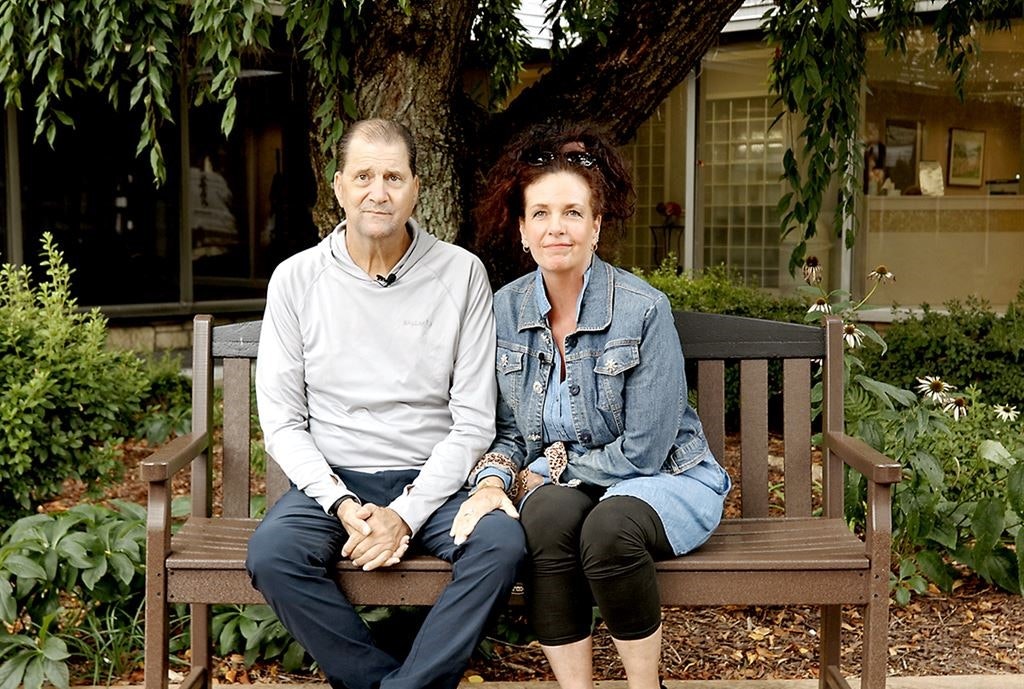Jim Patterson worried he had COVID after the onset of night sweats and swollen lymph nodes in his neck, shoulders, and armpits during the height of the pandemic. Afraid he might miss work, Patterson, a trucker from Cumberland, Maryland, visited urgent care and was prescribed antibiotics.
When his condition didn’t improve after two weeks, his doctor sent him for tests. Two days later, Patterson learned he had a rare lymphoma that would require aggressive treatment, including a stem cell transplant at the WVU Cancer Institute.
“I’ve heard of people with lymphoma,” Patterson, 65, said. “They take some treatments, and everything’s ok. I had what they call t-cell lymphoma, which is, from what I understand, as bad as it can get.”
Patterson was diagnosed with angioimmunoblastic t-cell lymphoma, a rare, fast-growing blood cancer that attacks part of the body’s immune system. Treatment typically involves a combination of different chemotherapy drugs, a stem cell transplant, or targeted therapies.
Patterson began chemotherapy with a local oncologist. Once he finished his chemotherapy regimen, he visited the WVU Cancer Institute, where he prepared for a stem cell transplant, a process that uses blood cells called stem cells to replace bone marrow damaged by cancer treatment. The stem cells eventually grow into new, healthy bone marrow.
The WVU Cancer Institute is the only facility in the state to offer blood and marrow transplants. The Osborn Hematopoietic Malignancy and Transplantation Program, the WVU Cancer Institute’s accredited blood and marrow transplant program, is staffed by transplant-trained physicians, hematologists, pharmacists, nurses, and supportive care specialists with years of experience.
A stem cell transplant is a complex procedure that requires patients to stay close to the hospital or be hospitalized for an extended period. In addition, several days of pre-transplant chemotherapy are necessary to destroy any remaining cancer cells and to make room in the bone marrow for the new cells to grow. The stem cells used in the transplant are collected from either the circulating blood of the patient or a donor. Patients use their own stem cells in an autologous transplant, and donor stem cells are used in an allogenic transplant.
The stem cells are infused into the patient, and these cells eventually enter the bone marrow and start making new blood cells, a process called engraftment. During this time, patients are highly susceptible to infections and could experience symptoms such as low blood cell counts, fatigue, bleeding, and fever.
Patients gradually begin to feel better as the new stem cells continue to grow into healthy blood cells and multiply. This process can take at least a month or longer, depending on the patient and the severity of side effects.
Recovery from an allogenic transplant usually takes longer, since patients receiving stem cells from a donor could face additional complications like graft-versus-host-disease (GVHD), which happens when the donor cells attack the patient’s body.
Patterson said the five days of high-dose chemotherapy before the transplant were the worst part of the process.
“It takes away your drive,” he said. “It actually takes away your will to live. But you go through it for the people that you love and the people that love you.”
Patterson’s caregiver and partner, Tracy Adams, stayed with him at the Rosenbaum Family House throughout the entire process. They lived there for a month and a half, until Patterson was declared cancer free in May 2021, and they could safely move back to Cumberland.
During a follow-up visit 18 months later, Patterson was devastated to learn that his cancer had returned.
“His disease had progressed through chemotherapy and a transplant, so we knew we were dealing with an aggressive cancer,” Konstantinos Sdrimas, MD, transplant program hematologist, said. He had just taken over Patterson’s care and met him a few months before his disease returned.
Dr. Sdrimas told Patterson his only option to be cured was to have another stem cell transplant, this time using donor stem cells.
Patterson, who had been prepared for the worst possible outcome, felt relieved when he learned he had an option – even if it was a difficult procedure he’d have to endure a second time.
“When you find out there’s an option, it lifts you up,” Patterson said.
Nobody in Patterson’s family matched his genetic blood cell markers, so an unrelated donor was found in the United Kingdom. Then, like his previous transplant, Patterson underwent a course of high-dose chemotherapy before the infusion of stem cells.
Patterson described the second transplant as “much worse” than the first. He had difficulty eating and drinking, suffered from extreme fatigue, and faced GVHD complications in his liver and skin. Even as he slowly started to regain his strength, Patterson had trouble getting dressed, showering, and walking, so he relied on Adams to help him with nearly everything.
“A good caregiver, and I had one, that makes and breaks it for you,” Patterson said.
It took Patterson almost four months to recover enough to return home.
Now, two years later, he’s cancer free.
“I’m so proud of him because he’s been through so much,” Adams said. “To see him doing so good now, it really is nothing short of a miracle.”
“I was very impressed by his strength and his resilience during that process,” Sdrimas said. “I’m very happy to say that he’s doing great.”
Both Patterson and Adams praised the entire staff at the WVU Cancer Institute, from the doctors and nurses to the receptionists and orderlies. Patterson had a choice of hospitals for his treatment, and he was happy that he chose the WVU Cancer Institute.
“I got the grand prize,” he said. “This is the best facility I could ever have dreamed up. The doctors are great. The facilities are great. Everybody’s wonderful.”
Life is mostly back to normal for Patterson, who is happy to share his story to help others.
“Hang in there,” Patterson said. “Don’t give up. Treat every day like it’s your first.”
Watch Patterson’s courageous story in a video available here.
